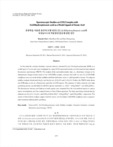

-
 * 본 문서는 배포용으로 복사 및 편집이 불가합니다.
* 본 문서는 배포용으로 복사 및 편집이 불가합니다.
미리보기
서지정보
· 발행기관 : 한국방사성폐기물학회
· 수록지 정보 : 방사성폐기물학회지 / 9권 / 4호
· 저자명 : Wansik Cha, Hye-Ryun Cho, Euo Chang Jung
목차
Abstract 요약 I. 서론 II. 재료 및 방법 가. 시료 용액 준비 과정 나. UV-Vis 흡광도 측정 및 분석 다. 시간분해 레이저유도 형광 측정 및 형광 소광효과 분석 Ⅲ. 결과 및 논의 가. 물 시료와 콜로이드 입자 시료의 문턱 에너지 나. 착물형성상수 및 착물종의 몰흡광계수 측정 다. DHB에 의한 U(VI) 화학종의 형광소광 효과 측정 라. 형광 소광 효과 분석 및 해석: Stern-Volmer Analysis Ⅳ. 결론 감사의 글 참고문헌초록
UV-Vis 분광광도법과 시간분해 레이저 유도 형광분광법(TRLFS)을 이용하여 흄산의 모사 리간드로 사 용한 2,6-Dihydroxybenzoate(DHB)와 U(VI)의 착물형성반응을 조사하였다. U(VI)-DHB 착물 고유의 전 하이동 흡수 스펙트럼을 분석한 결과, 착물형성반응은 우라늄-리간드 비가 1:1 또는 1:2 착물을 형성하는 이중 평형반응이며, 산도에 따라 착물종의 분포가 변한다는 것을 밝혔다. 계산된 착물형성상수 (log K1and log K2)는 12.4±0.1과 11.4±0.1이다. 이에 더하여, TRLFS 방법으로 조사한 결과, DHB는 U(VI) 화 학종들의 형광 소광제(quencher)로서 역할을 한다는 것을 확인하였다. 특히, 확인된 U(VI) 화학종 모두 (UO2 2+, (UO2)2(OH)2 2+과 (UO2)3(OH)5 +)에서 정적 (static) 및 동적 (dynamic) 소광작용이 공존하는 것으 로 관찰되었다. 시간분해 형광 스펙트럼으로부터 리간드 농도에 따른 U(VI) 화학종의 형광세기와 형광수 명을 측정하였으며, Stern-Volmer 식을 이용하여 분석하였다. 결정된 정적소광계수(KS)는 UO2 2+, (UO2)2(OH)2 2+ 과 (UO2)3(OH)5+에 대하여 각각 4.2±0.1, 4.3±0.1 과 4.34±0.08이다. Stern-Volmer 식 을 이용한 분석 결과, 단일 또는 이중 배위자 구조(mono- and bi-dentate)의 U(VI)-DHB 착물이 모두 정 적소광효과에 관여하는 바닥상태 착물임을 확인하였다.영어초록
In this study the complex formation reactions between uranium(VI) and 2,6-dihydroxybenzoate (DHB) as a model ligand of humic acid were investigated by using UV-Vis spectrophotometry and time-resolved laser-induced fluorescence spectroscopy (TRLFS). The analysis of the spectrophotometric data, i.e., absorbance changes at the characteristic charge-transfer bands of the U(VI)-DHB complex, indicates that both 1:1 and 1:2 (U(VI):DHB) complexes occur as a result of dual equilibria and their distribution varies in a pH-dependent manner. The stepwise stability constants determined (log K1 and log K2) are 12.4 0.1 and 11.4 0.1. Further, the TRLFS study shows that DHB plays a role as a fluorescence quencher of U(VI) species. The presence of both a dynamic and static quenching process was identified for all U(VI) species examined, i.e., UO2 2+, (UO2)2(OH)2 2+, and (UO2)3(OH)5 +. The fluorescence intensity and lifetimes of each species were measured from the time-resolved spectra at various ligand concentrations, and then analyzed based on Stern-Volmer equations. The static quenching constants (log Ks) obtained are 4.2 0.1, 4.3 0.1, and 4.34 0.08 for UO2 2+, (UO2)2(OH)2 2+, and (UO2)3(OH)5 +, respectively. The results of Stern-Volmer analysis suggest that both mono- and bi-dentate U(VI)-DHB complexes serve as groundstate complexes inducing static quenching.참고자료
· 없음태그
-
자료후기
-
자주묻는질문의 답변을 확인해 주세요

꼭 알아주세요
-
본 학술논문은 (주)코리아스칼라와 각 학회간에 저작권계약이 체결된 것으로 AgentSoft가 제공 하고 있습니다.
본 저작물을 불법적으로 이용시는 법적인 제재가 가해질 수 있습니다. -
해피캠퍼스는 구매자와 판매자 모두가 만족하는 서비스가 되도록 노력하고 있으며, 아래의 4가지 자료환불 조건을 꼭 확인해주시기 바랍니다.
파일오류 중복자료 저작권 없음 설명과 실제 내용 불일치 파일의 다운로드가 제대로 되지 않거나 파일형식에 맞는 프로그램으로 정상 작동하지 않는 경우 다른 자료와 70% 이상 내용이 일치하는 경우 (중복임을 확인할 수 있는 근거 필요함) 인터넷의 다른 사이트, 연구기관, 학교, 서적 등의 자료를 도용한 경우 자료의 설명과 실제 자료의 내용이 일치하지 않는 경우
“방사성폐기물학회지”의 다른 논문도 확인해 보세요!
-
Patent Analysis for Pyroprocessing of Spent Nuclear Fuels 12 페이지
사용후핵연료의 파이로처리기술에 대한 국내외 특허동향을 분석하였다. 1975-2009년에 걸쳐 한국, 미국, 일 본 및 유럽연합에서 출원된 특허에 대하여 출원국별, 출원인별, 연도별 및 세부기술분야별로 구분하여 그 내 용을 비교함으로써 파이로처리기술 개발 현황을 분석하였다. 그리고 주요 출원인의 세부기술별 특허활동지수 로부터 특정분야의 기술개발 편중도, 분석.. -
Sensitivity Analysis of Depletion Parameters for Heat Load Evaluation .. 9 페이지
후쿠시마 사고 이후 사용후핵연료 저장시설 안전성 재검증 필요성이 증대되고 있는 가운데, 재검증 결 과의 신뢰성 향상을 위해 열부하 평가결과의 정확도 향상이 요구되고 있다. 이를 위한 기초연구로 본 연 구에서는 상대적으로 중요성이 저평가되었던, 저장시나리오, 연소조건 관련 인자와 같이 붕괴열 및 열부 하 평가 영향인자를 도출하고, 고리 4호기를 대상으로 OR.. -
Safety Review of Severe Accident Senario for Wet Spent Fuel Storage Fa.. 6 페이지
지난 2011년 3월의 후쿠시마 원전 사고시 원자로 건물에서의 연쇄적인 수소폭발이 발생하였을 때 관계 자들은 제1원전 4호기의 폭발에 더욱 놀랐었는데 이는 그 당시 4호기는 정기보수를 위하여 원자로내 모 든 핵연료를 저장조에 보관중이었기 때문이다. 저장조내 냉각수 유실로 노심에서 옮겨진 핵연료가 공기 중에 노출되어 수소가 발생하고 임계가 도달하였다면 더욱 .. -
Nuclear Fuel Cycle Analysis Technology to Develop Advanced Nuclear Fue.. 12 페이지
핵연료주기 분석 연구는 핵연료주기 단계에서 기술들을 분석하고 요건들을 도출하여 국가적 핵연료주기 정책 설정 및 추진을 체계적으로 수행하기 위한 연구이다. 시스템 분석 기술은 대상 시스템의 비교 분석 평가 에 활용되며 핵연료주기를 대상으로 하는 경우 각 국가 또는 관심 범위에 따라 다양한 방법이 사용된다. 본연구에서는 국내 선진 핵연료주기 개발을 위해 필요한.. -
Influence of Water Salinity on the Hydraulic Conductivity of Compacted.. 8 페이지
다양한 건조밀도를 가진 압축벤토나이트의 수리전도도에 물의 염도가 미치는 영향이 조사되었다. 압축벤토 나이트의 수리전도도는 벤토나이트의 건조밀도가 상대적으로 낮은 경우에만, 염도가 증가함에 따라 증가하였 으며, 염도의 증가에 따른 수리전도도의 증가 정도는 벤토나이트의 건조밀도가 낮을수록 더 현저하였다. 건조 밀도가 1.0 Mg/m3 및 1.2 Mg/m3 인 ..
문서 초안을 생성해주는 EasyAI


